
Analysis of 25 nm functionalized QDs using fluorescence-NTA with ZetaView® QUATT system
Application Note Download Abstract While it is uncertain how far the NTA community is able to push the limits of current technology in order to

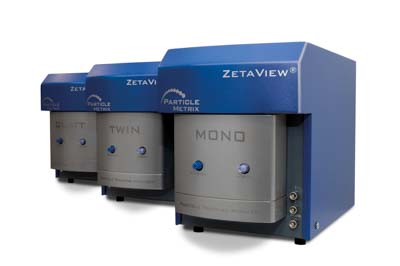
0x consumables
5x faster switching
10x faster cleaning
12x fluorescence channels
∞x statistics
…and much more!

We measure your products in a measuring range of 0.8 nm to 300 μm, if possible in original concentration
Particle Metrix, developers of versatile particle characterization solutions for the life sciences, report on the work in the Liu Laboratory at Augusta University which is studying exosomes where size and concentration are critical parameters.
Dr Yutao Liu is an Associate Professor in the Department of Cellular Biology & Anatomy at Augusta University. The research goal of his group is to identify potential biomarkers for several human diseases. As a human genetics research lab, they are interested in studying how exosomes and its contents contribute to the development of glaucoma, such as primary open-angle glaucoma and exfoliation glaucoma. They use human aqueous tumor and serum samples to explore exosomes and their contents. They are further interested in studying the role of exosomes in serum and other body fluids in relation to aging, smoking cessation and other age-related disorders. The Laboratory collaborates with many researchers interested in the study of exosomes.
Dr Liu’s group started to study exosomes in 2012. In the early days, they learned that it was very critical to know the size and the concentration of nanoparticles in their study samples prior to the characterization of protein and RNA contents. He selected the ZetaView® system from Particle Metrix as it provided quick, efficient and reliable measurements of particle size and concentration. Dr Liu said “Its innovative design with 11-position measurement throughout the cell enables the high accuracy and reliability of the actual measurement by avoiding measuring the same particles repeatedly. In addition, ZetaView measures zeta potential with the same instrument. After comparing ZetaView with other available platforms, we are confident that ZetaView matches to our research needs better than other commercial platforms. Having tried other systems at the core facility at UNC, Chapel Hill, we purchased our ZetaView in 2014 and now use it exclusively.”
Describing why he thinks the design of the instrument is particularly strong, Dr Liu continues: “In comparing to other particle characterization systems, ZetaView is superb in providing more accurate measurement about particle size and concentration. The 11-position measurement together with the 10x lens enables the measurement of larger volume in the actual sample by avoiding measuring the same particles again and again. The software interface is very user-friendly and Particle Metrix has provided great technical support to solve any requests we had for change. The recent improvements in the hardware and software algorithms make particle characterization much easier, less time-consuming and more accurate. Also, ZetaView is able to measure zeta potential very reliably. We have done hundreds of measurements on zeta potential. So far, we have characterized particle size and concentration with over 1,000 samples.”

Application Note Download Abstract While it is uncertain how far the NTA community is able to push the limits of current technology in order to
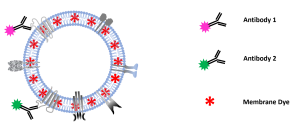
After successfully showing C-NTA of double-stained MSC-EVs in our previous study (https://bit.ly/43GG0Yk) and confirming
the results with image flow cytometry, this note describes C-NTA of multi-stained MSC-EVs using a PMX-430 QUATT NTA
system with four lasers.
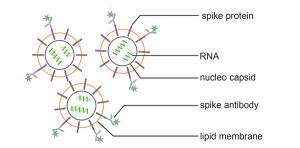
In this new application note we describe a quick determination of the physical titer of coronaviruses by fluorescence-based Nanoparticle Tracking Analysis and specific spike antibody recognition.
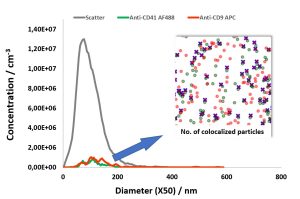
In this report, we describe the quantification of colocalization ratios on double-stained MSC-derived EVs using fluorochrome conjugated antibodies against the
cell surface antigens CD9 and CD41, which also serve as EV marker proteins.
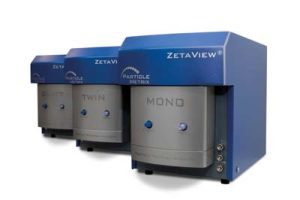
In addition to using Nano Particle Tracking Analysis (NTA) to measurement the size distribution and concentration of EV samples, both Microfluidic Resistive Pulse Sensing (MRPS) and the Single Particle Interference Reflectance Image Sensor (SP-IRIS) methods have been widely used as an alternative means of characterizing EVs. In this note, we relay two specific cases for using the ZetaView® NTA system to achieve relative “high-throughput” analysis of many EV samples, along estimations of throughput for MRPS & SPIRIS methods for an equivalent number of samples; further, we establish realistic estimates for the high cost of ownership for operating MRPS & SP-IRIS systems as a result of the cost of consumables as well as the substantially greater amount of time spent to run the same number of samples.
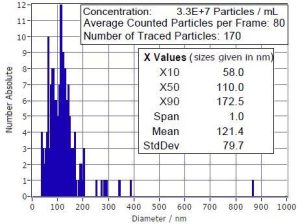
Along with generally accepted methods are some “tricks of the trade” such as the addition of Tween® or BSA; however, some of those additions are problematic.
Headquarter
Support
Opt-out abgeschlossen; Ihre Besuche auf dieser Webseite werden nicht vom Webanalysetool erfasst. Bitte beachten Sie, dass auch der Matomo-Deaktivierungs-Cookie dieser Webseite gelöscht wird, wenn Sie die in Ihrem Browser abgelegten Cookies entfernen. Außerdem müssen Sie, wenn Sie einen anderen Computer oder einen anderen Webbrowser verwenden, die Deaktivierungsprozedur nochmals absolvieren.
Sie haben die Möglichkeit zu verhindern, dass von Ihnen hier getätigte Aktionen analysiert und verknüpft werden. Dies wird Ihre Privatsphäre schützen, aber wird auch den Besitzer daran hindern, aus Ihren Aktionen zu lernen und die Bedienbarkeit für Sie und andere Benutzer zu verbessern.
Die Tracking opt-out Funktion benötigt aktivierte Cookies.